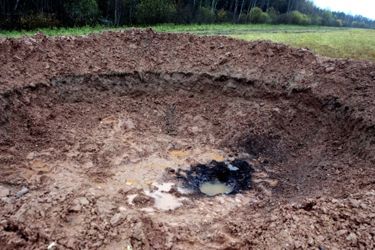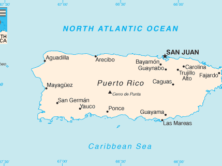
A crater, originally reported to have been made by a meteorite impact, but later revealed to be a hoax. (Credit: Apollo.lv)
In recent weeks, the media has reported on a number of hoaxes. First, Balloon Boy; then, a fake Chamber of Commerce press conference; and now, the Latvian Meteorite.
A phony meteorite impact near the northern town of Mazsalaca, perpetrated by a local telephone company, was briefly picked up by the press on October 26 and almost as quickly debunked. Phil Plait, the astronomer behind the blog BadAstronomy, gave a rundown of the fake impact story.
Plait writes that he was preparing a post questioning the meteorite story when geologists confirmed that the purported impact crater was in fact man-made. “I had a blog post all ready to go saying this whole thing sounded extremely fishy to me, and before I could post it I found out this story has been confirmed as a fake,” he says.
Though few media outlets were taken in completely by the hoax, some reported the story a little too credulously. Plait cites CNN, for writing early Monday morning “a meteorite-like object falls in Latvia.” (This post has been subsequently replaced with one debunking the meteorite theory, but the original report survives in a cached version of the page.)
The Associated Press also published a brief report saying “the rock-like object was seen Sunday evening. It punched a hole 15 meters (50 feet) wide and 5 meters (16 feet) deep in a meadow next to a farm in northern Latvia.” Later, geologists examining the crater found spade marks and determined that a meteorite had not, in fact, created the hole.
Overall, Plait’s analysis suggests that this wasn’t really much of a hoax, and probably should have been easy to spot. Video footage of the meteorite was suspect, as were photographs of the crater, he says.
“I could see immediately I was right; the crater simply doesn’t look real. It looks more like what someone thinks a crater should look like than what one actually does look like,” he writes.
“And if I didn’t buy the crater, I really super duper didn’t buy the flaming rock sitting in the center. Meteorites tend not to be hot on impact!… So I was almost completely positive the video was a fake right after seeing it, and I’m glad to see my instincts were correct.”
By the evening of Oct. 26, reports that the crater was a fake had already been widely published. If CNN had just waited a few hours they might have saved themselves that first over-credulous post. As media critics like Craig Silverman–writing for the Columbia Journalism Review—have argued, these hoaxes highlight that even a small amount of hold-time can often prevent inaccurate reporting.
Read Plait’s meteorite debunking in full here.







Comments Terms and Conditions